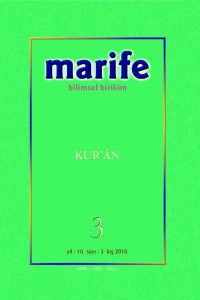Abstract
based on, exhibits the first and most important model of content and form belong- ing to fine arts. Since copying was prioritized as far as the Koran was concerned ini- tially, not much attention was attached to illumination. The idea of decoration, or ornamentation, is thought to have originated in the first century after the decease of Prophet Muhammad, though this is not for certain. The Korans, which have been seen as masterpieces by Muslim artists for centuries, reached a culmination in Ana- tolia with the 16th century Ottoman art of illumination. The spaces that were illumi- nated in the classical Ottoman Koran illumination are Zahriye (bookback page), ser- levha (front page), hatime (last page), surah titles, periods between verses, and the roses in the text margins
Abstract
İslam kültür ve medeniyetinde sanatların dayandığı temel olan Kur’an-ı Kerim, güzel sanatlara ait muhteva ve formun ilk ve en önemli modelini teşkil eder. İlk dönemlerde Mushaflarda önceliğin istinsah olması sebebiyle bu dönemde tezyinata fazla önem verilmemiştir. Bezeme fikri kesin olarak bilinmemekle birlikte, Hz. Peygamberin vefatını takip eden ilk yüzyıl içinde ortaya çıktığı tahmin edilmektedir. Yüzyıllar boyunca Müslüman sanatçılar tarafından her zaman şaheser olarak görülen Mushaflar, diğer İslam ülkelerinin yanı sıra Anadolu coğrafyasında da Osmanlı tezhip sanatı ile mükemmele ulaşmıştır. Klasik Osmanlı Mushaf tezyinatında tezhiplenen alanlar Zahriye sayfası, serlevha (baş sayfa), hatime sayfası(bitiş sayfası) sûre başlıkları, ayet aralarındaki duraklar, metin kenarlarındaki güllerdir
Keywords
Details
| Other ID | JA57HT44NT |
|---|---|
| Journal Section | Research Article |
| Authors | |
| Publication Date | December 31, 2010 |
| Published in Issue | Year 2010 Volume: 10 Issue: 3 |
This work is licensed under a Creative Commons Attribution-NonCommercial 4.0 International License.

